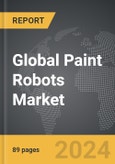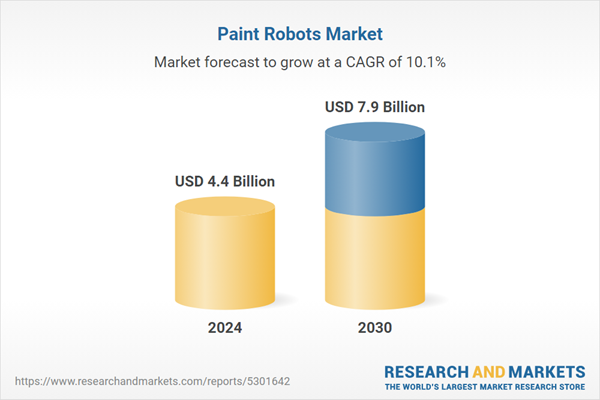Global Paint Robots Market - Key Trends & Drivers Summarized
What Are Paint Robots & Why Are They Essential in Industrial Coating?
Paint robots are automated machines designed to apply paint, coatings, and finishes on a wide range of products in manufacturing environments. Equipped with robotic arms, spray guns, sensors, and control systems, these robots deliver precise, uniform, and consistent paint application on surfaces, improving the quality and efficiency of the coating process. Paint robots are primarily used in industries like automotive, aerospace, consumer goods, and general manufacturing, where high-quality finishes and productivity are critical. These robots can be programmed to handle various shapes, sizes, and textures, offering flexibility and consistency in paint application.The demand for paint robots has grown significantly due to the rising need for automation in manufacturing, the increasing complexity of designs, and the demand for high-quality, uniform finishes. In the automotive industry, paint robots are used in assembly lines to coat car bodies, parts, and accessories, ensuring a smooth, even finish with minimal waste. In the aerospace sector, they are employed to apply protective coatings on aircraft components, reducing the risk of corrosion and improving durability. Paint robots are also used in industries like electronics, furniture, and heavy machinery, where they help achieve consistent paint application, reduce labor costs, and enhance workplace safety by minimizing workers' exposure to toxic fumes and hazardous chemicals. With their ability to deliver consistent quality, reduce production time, and increase safety, paint robots have become essential in modern manufacturing.
How Do Paint Robots Improve Coating Quality & Operational Efficiency?
Paint robots enhance coating quality by delivering precise and consistent paint application, eliminating common defects like overspray, drips, uneven coverage, and thickness variations. Equipped with advanced sensors and programmable spray patterns, these robots adjust the spray angle, speed, and distance to achieve optimal coverage across complex surfaces and geometries. This precision ensures that paint is applied evenly, leading to a superior finish with minimal wastage of paint and other coating materials. In industries like automotive and consumer electronics, where aesthetics and product appeal are crucial, paint robots help achieve high-gloss, uniform finishes that enhance the visual appeal and durability of products.In addition to improving coating quality, paint robots significantly increase operational efficiency by automating the painting process, reducing cycle times, and minimizing labor costs. By operating continuously and consistently, paint robots can cover large surface areas in less time compared to manual painting methods. Their ability to maintain a constant spray pattern and flow rate reduces paint consumption and energy usage, leading to cost savings and more sustainable operations. Paint robots also contribute to a safer work environment by reducing human exposure to volatile organic compounds (VOCs), hazardous chemicals, and other health risks associated with manual painting. Features like automated cleaning, rapid color changes, and integrated drying systems further enhance productivity, making paint robots an efficient solution for high-volume manufacturing.
How Are Technological Advancements Shaping the Development of Paint Robots?
Technological advancements have significantly improved the performance, flexibility, and capabilities of paint robots, making them more effective for diverse industrial applications. One of the major innovations in this field is the development of high-precision, six-axis robotic arms, which offer a wide range of motion and greater flexibility. These robots can navigate complex shapes and angles, ensuring thorough paint coverage even in hard-to-reach areas. Advanced programming techniques, such as offline programming and simulation, allow manufacturers to design and optimize paint patterns, trajectories, and spray parameters before implementation, reducing setup time and minimizing errors. This makes the integration of paint robots faster, easier, and more cost-effective.Another significant advancement is the integration of artificial intelligence (AI) and machine learning algorithms into paint robots, enabling real-time adjustments during the painting process. AI-powered robots can analyze paint thickness, surface quality, and environmental conditions, making dynamic adjustments to maintain consistent quality. Vision-based systems, such as 3D scanners and cameras, enhance the robots' ability to detect surface irregularities, adjust spray patterns, and apply corrective coatings where needed. In addition, the use of smart sensors and IoT connectivity has enabled predictive maintenance of paint robots, reducing downtime and increasing overall reliability. The adoption of lightweight materials, such as carbon fiber components, in robotic arms has improved the speed and energy efficiency of paint robots, making them more suitable for fast-paced production lines. These technological advancements have not only increased the efficiency of paint robots but also expanded their applications across various industries, supporting better quality control, reduced waste, and improved sustainability.
What Factors Are Driving Growth in the Paint Robots Market?
The growth in the paint robots market is driven by several factors, including the increasing demand for automation in manufacturing, rising labor costs, advancements in robotics technology, and the need for higher product quality and consistency. The global trend toward automation has encouraged manufacturers across industries to adopt paint robots as a means to increase productivity, reduce costs, and ensure consistent product quality. In the automotive sector, paint robots are used extensively in production lines, where high throughput and uniform coating are critical for maintaining quality and meeting production targets. The expansion of electric vehicle (EV) production has further fueled demand for paint robots, as EV manufacturers focus on lightweight materials, precision coatings, and fast production cycles.The growing emphasis on sustainability and reducing environmental impact has also contributed to the adoption of paint robots. By enabling precise paint application and reducing overspray, these robots help minimize paint waste, energy consumption, and VOC emissions, supporting manufacturers' efforts to comply with environmental regulations and sustainability goals. The increasing complexity of product designs in industries like aerospace, consumer electronics, and appliances has further driven demand for flexible, high-precision paint robots that can handle intricate shapes and surfaces. Additionally, the rise of smart factories and Industry 4.0 initiatives has created new opportunities for paint robots equipped with AI, IoT, and real-time monitoring capabilities, enabling better integration, predictive maintenance, and data-driven process optimization.
Emerging markets, particularly in Asia-Pacific and Latin America, are witnessing rapid industrialization and expansion of manufacturing sectors, driving demand for automated solutions like paint robots. The growing adoption of robotic solutions in small and medium-sized enterprises (SMEs), driven by cost reductions, improved ROI, and government incentives, has further expanded the market. With continued advancements in robotics, increasing focus on quality control, and the need for sustainable production, the paint robots market is poised for sustained growth, supported by evolving manufacturing needs, technological innovations, and global automation trends.
Report Scope
The report analyzes the Paint Robots market, presented in terms of market value (US$ Thousand). The analysis covers the key segments and geographic regions outlined below.- Segments: Type (Robotic Arm, Pedestal Robots); End-Use (Automotive & Transportation, Construction, Consumer Appliances, Furniture, Foundry & Casting, Textiles, Other End-Uses).
- Geographic Regions/Countries:World; United States; Canada; Japan; China; Europe (France; Germany; Italy; United Kingdom; Spain; Russia; and Rest of Europe); Asia-Pacific (Australia; India; South Korea; and Rest of Asia-Pacific); Latin America (Argentina; Brazil; Mexico; and Rest of Latin America); Middle East (Iran; Israel; Saudi Arabia; United Arab Emirates; and Rest of Middle East); and Africa.
Key Insights:
- Market Growth: Understand the significant growth trajectory of the Robotic Arm segment, which is expected to reach US$5.1 Billion by 2030 with a CAGR of a 10.8%. The Pedestal Robots segment is also set to grow at 9% CAGR over the analysis period.
- Regional Analysis: Gain insights into the U.S. market, valued at $1.1 Billion in 2024, and China, forecasted to grow at an impressive 14.7% CAGR to reach $2.1 Billion by 2030. Discover growth trends in other key regions, including Japan, Canada, Germany, and the Asia-Pacific.
Why You Should Buy This Report:
- Detailed Market Analysis: Access a thorough analysis of the Global Paint Robots Market, covering all major geographic regions and market segments.
- Competitive Insights: Get an overview of the competitive landscape, including the market presence of major players across different geographies.
- Future Trends and Drivers: Understand the key trends and drivers shaping the future of the Global Paint Robots Market.
- Actionable Insights: Benefit from actionable insights that can help you identify new revenue opportunities and make strategic business decisions.
Key Questions Answered:
- How is the Global Paint Robots Market expected to evolve by 2030?
- What are the main drivers and restraints affecting the market?
- Which market segments will grow the most over the forecast period?
- How will market shares for different regions and segments change by 2030?
- Who are the leading players in the market, and what are their prospects?
Report Features:
- Comprehensive Market Data: Independent analysis of annual sales and market forecasts in US$ Million from 2024 to 2030.
- In-Depth Regional Analysis: Detailed insights into key markets, including the U.S., China, Japan, Canada, Europe, Asia-Pacific, Latin America, Middle East, and Africa.
- Company Profiles: Coverage of players such as ABB, CMA Robotics, Durr Systems, Epistolio S.r.l, Fanuc and more.
- Complimentary Updates: Receive free report updates for one year to keep you informed of the latest market developments.
Some of the 33 companies featured in this Paint Robots market report include:
- ABB
- CMA Robotics
- Durr Systems
- Epistolio S.r.l
- Fanuc
- Kawasaki Robotics
- Krautzberger
- Kuka Robotics
- Staubli
- Yaskawa
This edition integrates the latest global trade and economic shifts into comprehensive market analysis. Key updates include:
- Tariff and Trade Impact: Insights into global tariff negotiations across 180+ countries, with analysis of supply chain turbulence, sourcing disruptions, and geographic realignment. Special focus on 2025 as a pivotal year for trade tensions, including updated perspectives on the Trump-era tariffs.
- Adjusted Forecasts and Analytics: Revised global and regional market forecasts through 2030, incorporating tariff effects, economic uncertainty, and structural changes in globalization. Includes historical analysis from 2015 to 2023.
- Strategic Market Dynamics: Evaluation of revised market prospects, regional outlooks, and key economic indicators such as population and urbanization trends.
- Innovation & Technology Trends: Latest developments in product and process innovation, emerging technologies, and key industry drivers shaping the competitive landscape.
- Competitive Intelligence: Updated global market share estimates for 2025, competitive positioning of major players (Strong/Active/Niche/Trivial), and refined focus on leading global brands and core players.
- Expert Insight & Commentary: Strategic analysis from economists, trade experts, and domain specialists to contextualize market shifts and identify emerging opportunities.
Table of Contents
Companies Mentioned (Partial List)
A selection of companies mentioned in this report includes, but is not limited to:
- ABB
- CMA Robotics
- Durr Systems
- Epistolio S.r.l
- Fanuc
- Kawasaki Robotics
- Krautzberger
- Kuka Robotics
- Staubli
- Yaskawa
Table Information
| Report Attribute | Details |
|---|---|
| No. of Pages | 279 |
| Published | December 2025 |
| Forecast Period | 2024 - 2030 |
| Estimated Market Value ( USD | $ 4.4 Billion |
| Forecasted Market Value ( USD | $ 7.9 Billion |
| Compound Annual Growth Rate | 10.1% |
| Regions Covered | Global |









